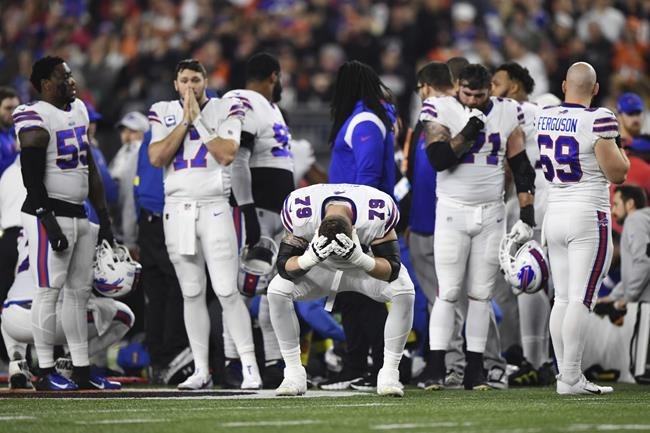Damar Hamlin's cardiac arrest on the field during Monday Night Football may serve as a wake-up call for many Canadians, says a spokesman for the Heart and Stroke Foundation.
"Anyone, anywhere, any age," said Andrew Lotto, senior manager of the foundation's resuscitation group, about who may suffer a cardiac arrest. He noted that NHLers like Rich Peverley and Jiri Fischer as well as Danish soccer player Christian Eriksen, among others, have also suffered cardiac arrest mid-game.
"It shows that this happens with enough frequency to athletes that it's going to happen to people in the public sphere as well."
Cardiac arrests are not uncommon in Canada, with the Heart and Stroke Foundation estimating that there are 35,000 across the country per year, or one every 15 minutes. Lotto said that nine out of 10 people who have an out-of-hospital cardiac arrest will not survive.
"But you can double and even triple the chance of survival with early CPR and defibrillation," said Lotto. "That's why it's so important that people call 9-1-1, that people start CPR as soon as they possibly can just by getting hard and fast on the centre of the person's chest, and that an AED (automated external defibrillator) is brought to their site and used immediately."
Hamlin's recovery is moving in "a positive direction" two days after the Buffalo Bills safety collapsed and went into cardiac arrest during a game in Cincinnati, the player's marketing representative said Wednesday.
The Bills said that Hamlin remained hospitalized in critical condition but displayed signs of improvement on Tuesday and overnight. They said he was expected to remain in intensive care as his medical team continued to monitor and treat him.
Hamlin was hurt in the first quarter when he was struck squarely in the chest while making what appeared to be a routine tackle of Bengals receiver Tee Higgins. Hamlin briefly got up and adjusted his facemask before collapsing backward.
Lotto said that what happened to Hamlin was "devastating" and he hopes the 24-year-old makes a complete recovery. However, he said that if the cardiac arrest had to happen, a football stadium is one of the most ideal possible locations.
"Having a huge audience, a bunch of trained medical responders, and the right equipment nearby makes it so that he actually has a better chance than the average citizen of surviving a cardiac arrest because the response was immediate to his situation," said Lotto. "Everybody acted as you would hope that they would act by immediately getting the right people by his side, starting CPR, using a defibrillator, and ultimately doing everything they could to save his life."
Outside of hospitals and other medical facilities, Lotto said that sporting venues and airports have the appropriate infrastructure in place to help someone in cardiac arrest, including readily available defibrillators and people with medical training.
Although Manitoba and Ontario have provincial legislation in place to ensure that AEDs are easily accessed in most buildings, Lotto said there is still work to be done.
"Heart and Stroke really feels that defibrillators need to be as commonplace as fire extinguishers," said Lotto, adding that the federal government funded a Foundation program to place defibrillators in hockey rinks and other sporting facilities across the country years ago.
"You wouldn't go into a building and expect that they don't have smoke detectors and working fire equipment. You shouldn't go into a building and expect that they don't have a working defibrillator nowadays."
The Heart and Stroke Foundation has short videos on its website on how to quickly perform hands-only CPR, how to use a defibrillator, and other educational resources. It also offers in-person courses on CPR and encourages people to take classes through partner organizations like the Red Cross or St. John Ambulance.
— With files from The Associated Press.
This report by The Canadian Press was first published Jan. 4, 2023.
John Chidley-Hill, The Canadian Press



